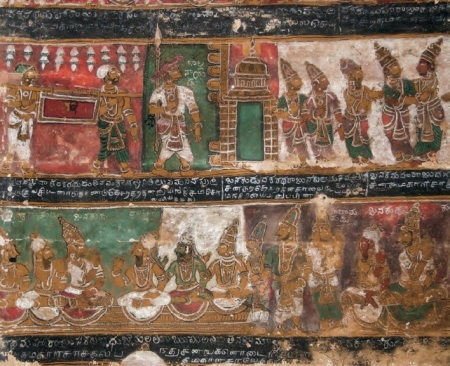My dissertation focuses on mural paintings of early modern southeastern India in the region of Tamil Nadu from 1500 to 1800. Of the roughly eighty mural sites I have recorded, I have documented more than twenty during my tenure as the Ittleson Fellow and have transcribed and translated many of the Tamil and Telugu inscriptions therein. The murals, which are on the walls and ceilings of temples and palaces, are organized in horizontal registers of narrative, iconic, and topographic images. Their pictorial subjects frequently relate to known texts, such as local mythologies, transregional epics, devotional poetry, and histories of sacred sites, saints, and rulers. Although narrative and label inscriptions are found only in some murals of the sixteenth century, by the eighteenth century, narrative inscriptions in the Tamil and Telugu languages consistently framed pictorial registers.
The period 1500–1800 was one of dramatic political, economic, and social change in southern India. It witnessed the dissolution of the Vijayanāgara empire, which at its height ruled most of southern India. When the empire fell (c. 1565), it splintered into smaller kingdoms controlled by nāyakas, Telugu-speaking warriors who had served as governors of the empire; this period is thus known as the Nāyaka period. The customs, etiquette, and language of the Vijayanāgara and Nāyaka courts persisted as signs of legitimate and cosmopolitan kingship. Telugu, as the language of the Nāyakas, was hence associated with political power and prestige, even among elites indigenous to the Tamil region.
The eighteenth-century mural paintings that cover the ceiling of the second entrance hall ceiling at the Bragadāmpāl Temple, just outside the modern city of Pudukkottai, exemplify the pictorial developments of the period. The Tamil Tondaiman kings of Pudukkottai are the assumed patrons of the murals, which narrate the first and second books of the Rāmāyana in alternating text and pictorial registers. I show that the murals actually recount the narrative thrice over: Tamil narrative inscriptions repeat Telugu narrative inscriptions in the text registers, and in the pictorial registers, images with Telugu labels repeat the narrative described above. Because the scripts of Tamil and Telugu are visually distinct, the repetition of the telling is visually apparent, even if semantically inaccessible for some viewers. I argue that text is crucial for the interpretation of Nāyaka-period mural paintings precisely because of its potential for both semantic and iconographic significance.
At all bilingual sites, most of which are associated with courtly patronage, Telugu and Tamil languages are systematically deployed; the pattern of deployment, however, varies among sites. In those like the Bragadāmpāl Temple, Tamil and Telugu narrative inscriptions convey the same information, while labels in the pictorial register employ one or the other language exclusively. At other sites, Tamil is the only language of narrative inscription, while Telugu is reserved for occasional inscriptions, to reiterate Tamil labels, or to indicate important persons, donors, books, or sacred sites. The specialized use of Telugu inscriptions for revered figures and objects indicates their elevated status but does not necessarily signal the imposition of an outside language or polity. I suggest that Telugu signals participation in the wider political and artistic cultures of the seventeenth and eighteenth centuries.
My study of Nāyaka-period murals combines detailed analysis of the images and inscriptions with the broader artistic, religious, and political contexts of their production and reception. In this project, I create a new archive for study and comparison and intervene in the dominant narrative of Indian painting by insisting on the inclusion and importance of the murals of early modern South India.
Members' Research Report Archive
Image and Text in Early Modern South Indian Murals
Anna Lise Seastrand [Columbia University]
Ittleson Fellow, 2010–2012
Upon entering the Chennaraya Perumal temple at Adiyamankottai, the devotee finds herself within a small hall, under a low ceiling covered with brightly painted figures and Telugu-language inscriptions. Proceeding toward the sanctum, she passes under the cosmic body of the god Viṣṇu; in the two aisles to left and right, she may glimpse the great epics, Mahābhārata and Rāmāyaṇa, narrated in alternating registers of picture and text. The murals are captivating; but despite the singularity of their subject, distinctive visual style, and nominal protection by the Archaeological Survey of India, they languish in obscurity. The few scholarly treatments the site has attracted are so contradictory as to confuse rather than enlighten any reading of the paintings: assessments of style vary from “courtly” to “folk,” opinions on date range from the sixteenth through the nineteenth century, and the presence of inscriptions is barely noted. These contradictions and absences are characteristic of the field: South Indian paintings of the early modern period have largely remained beyond the purview of documentation, interpretation, and protection.

The Meeting of Daśaratha and Janaka, eighteenth century, Bragadāmpāḷ temple, Tiru Gokarnam, Pudukkottai, Tamil Nadu. Author photograph